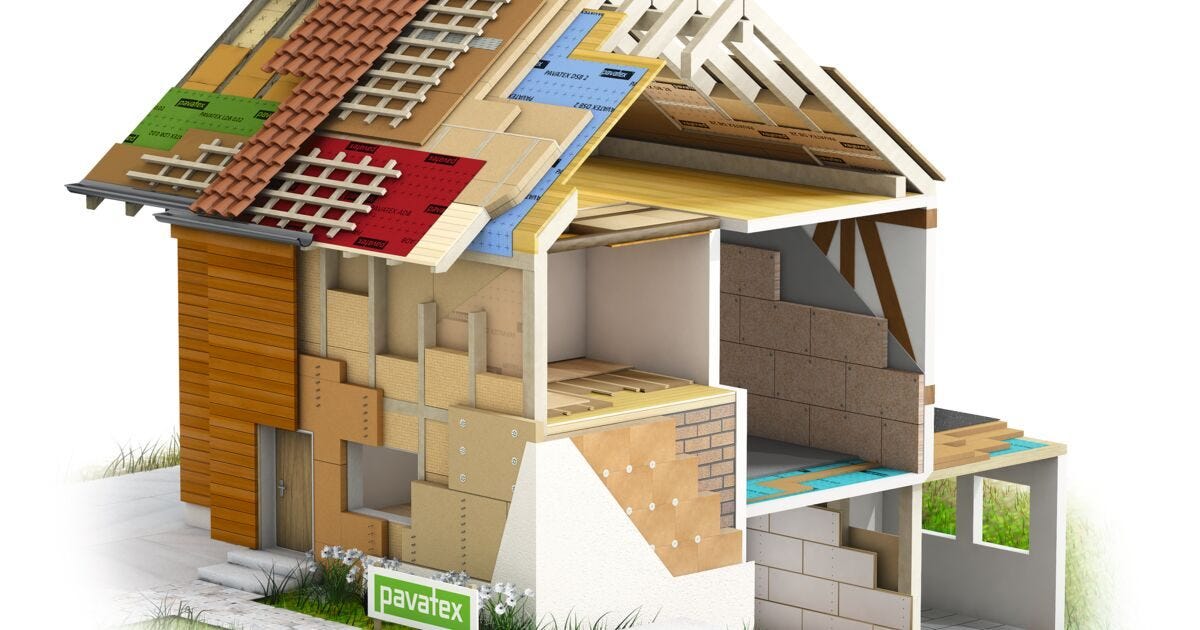
By Phil Griffiths, Development & Specification Director at SOPREMA UK.
In May 2019, the Royal Institute of British Architects acknowledged the state of climate and biodiversity emergency by launching the Architects Declare initiative. In June 2020, some of the UK’s largest contractors followed suit with their own climate emergency declaration, Contractors Declare. Just like the Stirling Prize-winning architects who issued the initial declaration, the contractors stated that, as buildings and construction “account for nearly 40% of energy-related carbon dioxide emissions, […] a paradigm shift in our behaviour [is in order].”
To make true on the pledge to design and build more eco-friendly buildings, natural insulation is key. SOPREMA, one of the market leaders in innovation and sustainability, offers PAVATEX; a range of wood fibre insulation products that are a more than worthy alternatives for chemical insulation. Carbon-negative, this premium product range boasts several technical properties that make it ideal for the UK market.
PAVATEX: Thermal, Moisture, Acoustic and Overheating Control
PAVATEX is a range of more than 95% natural and sustainable building materials manufactured from waste sawmill wood shavings. Each product locks up more carbon than is required to produce and transport it. PAVATEX materials are the perfect choice for architects and specifiers looking for greener solutions for both new builds and retrofit projects. Moreover, the insulation boards outperform their synthetic counterparts in various other ways.
1. Overheating control
As global warming continues, overheating in buildings is expected to increase. While conventional insulation cannot keep the sun’s high-level heat out in the summer, PAVATEX insulation prevents overheating thanks to its high density. Its thermal mass stores the heat from the outside during the day and releases it at night, ensuring pleasant room temperatures around the clock. More specifically, PAVATEX has a decrement delay of up to twelve hours, meaning that it can take twelve hours for the highest temperatures to pass through the building fabric.
2. Excellent breathability
Thanks to the hygroscopic properties of wood fibre, PAVATEX keeps the rain out while simultaneously allowing any moisture that is produced inside the building to pass through its porous structure. The material’s performance is, in other words, not adversely affected by moisture. Both airtight and naturally vapour-permeable, PAVATEX boards help regulate humidity levels in rooms. When the insulation gets damp, it simply dries out.
3. Thermal and Acoustic Performance
PAVATEX not only guarantees excellent thermal performance. Thanks to its density, the insulation materials also act as a barrier against noise, even performing beyond the legally specified noise-protection values.
PAVATEX: For New Builds and Refurbishments
PAVATEX wood fibre insulation boards are suitable for a wide range of applications, both in new build and refurbishment projects, such as pitched roofs and interior and exterior walls. In what follows, we will zoom in on the insulation of timber-framed buildings and solid walls – two of the many cases that demonstrate PAVATEX’ superior performance.
Timber-Framed Buildings
1. Moisture Penetration
When it comes to timber-framed buildings, protecting the wood from getting wet is obviously key to keeping the structure from degrading. Vapour-control barriers are often installed for this exact purpose, yet breaches due to electrical wires or other perforations are not uncommon. And when a vapour-control barrier is damaged, moisture (rain absorbed from the external surface, residual moisture, condensation accumulation or moisture from the ground) gets trapped in the wall behind the vapour barrier. This, in turn, can lead to rotting wall plates, lintels and embedded joist ends, or to mould growth causing health implications. It can also seriously compromise the insulation’s thermal performance. PAVATEX, however, is breathable and therefore prevents moisture from getting trapped within the structure. The materials thus ensure a much more robust timber-frame system in terms of moisture penetration.
2. Amount of Insulation Needed
In addition, PAVATEX systems put wood fibre around the outside of the building, decreasing heat loss through thermal bridging and hence reducing the amount of insulation that is potentially needed inside the walls. After all, the three factors that are responsible for heat loss in buildings – air tightness (the amount of air that leaks out of the building), the transfer of heat through a structure such as a wall (U-value) and heat loss through thermal bridging (Y-value) – are interconnected, meaning that lower Y-values can compensate for higher U-values. As the use of PAVATEX leads to significantly lower Y-values, less insulation is then needed inside the walls, which can subsequently be thinner – and still the thermal performance of the building as a whole will always be on point.
Solid Brick Walls
There’s a growing awareness that traditional ways of insulating solid walls – either by creating a cavity between the wall and the insulation, or by putting studs against the wall and filling the frame with insulation material – actually negatively affect the wall’s performance. After all, these methods make the wall colder and actually create more condensation between the wall and the insulation. The consensus now is that it is better to insulate a solid wall with hygroscopic insulation that ensures moisture absorption and redistribution. Thanks to PAVATEX’s active moisture control, any moisture that gets through has no chance to condense, making it a perfect choice for insulating solid brick walls.
PAVATEX: Availability
PAVATEX is readily available. The material is stocked with several distributors across the UK, so you will have no trouble getting your hands on it. Contact your local supplier, or get in touch with our waterproofing and insulation experts if you have any questions about PAVATEX.

